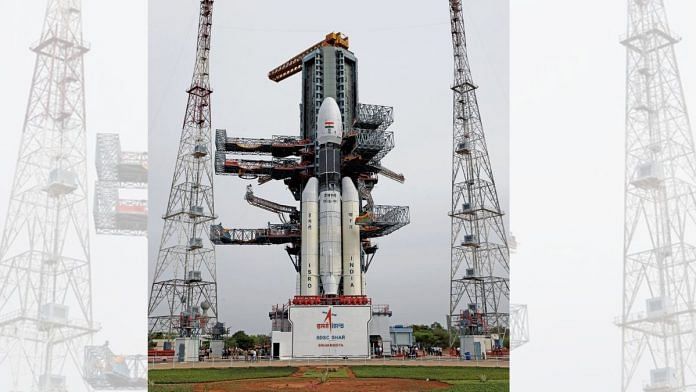New Delhi: The Indian Space Research Organisation (ISRO) has released images of the GSLV MkIII-M1 — the country’s biggest indigenous rocket — as the space agency makes final preparations for the much-awaited Chandrayaan 2 launch on 15 July.
The images show the 640-tonne rocket being placed onto the launch pad at the spaceport of Sriharikota in Andhra Pradesh.
According to S. Somnath, Director, Vikram Space Centre, at Thiruvananthapuram, when Chandrayaan 1 was launched, the Polar Satellite Launch Vehicle (PSLV) used then had the capacity to lift a weight of 1 tonne to the geostationary transfer orbit (GTO).
“The GSLV Mk-III is a four-metre diameter class rocket with a payload capability of 4 tonnes to GTO. This is the rocket that is going to carry our Chandrayaan 2 to the mid-orbit,” Somnath said in a video shared by ISRO.
The mission is being called the ‘most complex’ as this is the first time any country is attempting a soft landing near the south pole of the Moon. This is also the first time that India is sending a rover to space.
“Chandrayaan 2 (is) a technologically challenging mission requires multi-faceted developments of various new systems for the first time with a very high level of perfection,” said P. Kunhikrishnan, Director, U.R. Rao Satellite Centre (URSC), ISRO.
Also read: As the race for Moon heats up, Chandrayaan-2 could give ISRO an edge, and spoils
A three-in-one integrated spacecraft
Weighing about 3,850 kg, Chandrayaan 2 is a three-in-one integrated spacecraft with an orbiter, the Vikram lander and the Pragyaan rover.
“Fourteen science instruments in Chandrayaan 2 will provide useful data to the scientific community,” Kunhikrishnan said. “The challenge is to demonstrate our capacity to undertake such a complex mission for the soft and precise moon landing at its south polar region for the first time.”
Several state-of-art indigenous systems were conceived and realised in the areas of navigation, guidance, control, onboard autonomy, precision sensors, and intricate communication links involving orbiter, lander, rover, and ground systems for this mission.
“Subsequent to the launch a series of complex mission operations spanning over a period of 50 days will be carried out, leading to a soft landing in the early hours of 7 September — a remarkable milestone in the Indian space programme,” Kunhikrishnan said.
“Chandryaan 2 is going to an area that no country before has reached. That area is the South Pole of the moon,” said D.B. Pathak, principal of the Kendriya Vidyalaya, IISC.
“The Chandrayaan mission will inspire and motivate the youth and the children of the society to come out of the comfort zone, to think bigger and go beyond what is already achieved,” Pathak said.
Chandrayaan 2 incurred a cost of Rs 603 crore and involved 120 industries for its production and foreign ground station support. The GSLV rocket cost Rs 375 crore and nearly 500 industries were involved in its production.
The mission will analyse water on the lunar surface, monitor lunar quakes, dig and study minerals and more.
Also read: Why Chandrayaan-2 is ISRO’s ‘most complex mission’ so far



